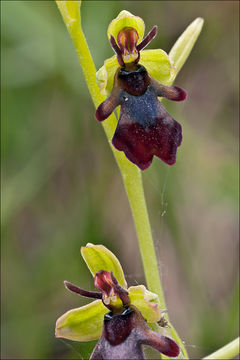Image of Ophrys insectifera ssp. insectifera

Description:
Slo.: muholiko maje uho - syn.: Ophrys muscifera Huds - Habitat: river bank composed of partly overgrown stony calcareous ground, partly scree, light mixed forest but quite open place, Picea abies, Fagus sylvatica, Pinus nigra, Fraxinus ornus dominant trees; flat terrain to moderately steep, east oriented mountain slope, half shade, high air humidity but mostly dry ground, exposed to direct rain, average precipitations ~ 3.000 mm/year, average temperature 7-9 deg C, elevation 535-545 m (1.750-1.800 feet), alpine phytogeographical region. - Substratum: stony soil. - Comment: Ophrys insectifera ssp. insectifera belongs to a genus, which has very interestingly shaped flowers. The plants simulate different insects by the shape of their flowers and in this way deceive them. The insects try to 'copulate' with the flowers and in this way transport pollen from plant to plant. However, self-pollination is also frequent phenomenon and such is also Ophrys insectifera ssp. insectifera. - Genus Ophrysis is typically a warmth loving Mediterranean floral element, but some species, like Ophrys insectifera ssp. insectifera, grow also in the Alps and also much more to the north. The genus is very differently treated by different botanists. Some distinguish over 200 species and subspecies; others recognize only a fraction of this number. In general distinguishing among them is a hard nut even for specialists due to large variability of the shape, colors and hairiness of the flowers. In addition, many fertile hybrids between species and also among hybrids themselves exist. Fortunately, Ophrys insectifera ssp. insectifera is an easily recognized exception in this mess. Its typical anterior lip, which is distinctly tripartite, with its deeply cleft middle section, is a reliable trait, which distinguishes Ophrys insectifera ssp. insectifera from all other species of the genus. - Ophrys insectifera ssp. insectifera can be found scattered in all regions of the Alps, but it is nowhere near a common plant. In Austria, north of us, for example, it is considered very rare, highly endangered and in some parts of the country assumed extinct. Also our atlas Ref.:(5) doesn't shows many alpine UTM squares (compared to other regions of Slovenia), where it has been found up to now. All the more I was happy to find this tiny plant in 2013 also in Koritnica valley deeoly in the Julian Alps on at least five different places. Almost twenty plants were blooming on a stretch of river bank not much longer than 1 km, usually growing solitary or in groups of two or three plants. - Protected according to 'Uredba o zavarovanih prostoiveih rastlinskih vrstah' Url. RS, t. 46/2004 (Regulation of protection of wild growing plants, Official Gazette of Republic Slovenia, No.:46/2004). Enlisted in the Slovene Red List of rare and endangered species, marked by 'V' representing a vulnerable species. - Ref.: (1) H. Baumann, S. Kuenkele, R. Lorenz, Orchideen Europas, Ulmer (2006), p 170. (2) M.A. Fischer, W. Adler, K. Oswald, Exkursionsflora sterreich Liechtenstein, Sdtirol, LO Landesmuseen, Linz, Austria (2005), p 1045. (3) D. Aeschimann, K. Lauber, D.M. Moser, J.P. Theurillat, Flora Alpina, Vol. 2., Haupt (2004), p 1138. (4) A. Martini et all., Mala Flora Slovenije, Tehnina Zaloba Slovenije (2007) (in Slovene), p 776. (5) N. Jogan (ed.), Gradivo za Atlas flore Slovenije (Materials for the Atlas of Flora of Slovenia), CKSF (2001), p 261. (6) H. Haeupler, T. Muer, Bildatlas der Farn- und Bluetenpflazen Deutschlands, Ulmer (2000), p 707.
Included On The Following Pages:
This image is not featured in any collections.
Source Information
- license
- cc-by-nc-sa-3.0
- copyright
- 2014 Dr. Amadej Trnkoczy
- photographer
- Dr. Amadej Trnkoczy
- original
- original media file
- visit source
- partner site
- CalPhotos
- ID


